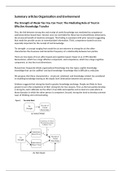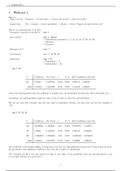Summary articles Organisation and Environment
The Strength of Weak Ties You Can Trust: The Mediating Role of Trust in
Effective Knowledge Transfer
First, the link between strong ties and receipt of useful knowledge was mediated by competence-
and benevolence-based trust. Second, once we controlled for these two trustworthiness dimensions,
the structural benefit of weak ties emerged. This finding is consistent with prior research suggesting
that weak ties provide access to nonredundant information. Third, competence-based trust was
especially important for the receipt of tacit knowledge.
Tie strength- a concept ranging from weak ties at one extreme to strong ties at the other-
characterizes the closeness and interaction frequency of a relationship between two parties.
There are two types of trust; affect based and cognition based. Mayer et al. (1995) identify
benevolence, which has a large affective component, and competence, which has a large cognitive
component, as two key trust dimensions.
Researchers frequently divide organizational knowledge into two types: explicit knowledge -
knowledge that can be codified- and tacit knowledge- knowledge that is difficult to articulate.
We propose that three characteristics - structural, relational, and knowledge related- be considered
in modeling knowledge sharing at the dyadic level (interaction between two persons).
Evidence suggests that strong ties lead to greater knowledge exchange. People are likely to have
greater trust in the competence of their strong ties for two reasons. First, as the two parties develop
a strong tie, each calibrates on the other's true skills and expertise and so learns to seek advice in
those domains in which the other person is competent. Second, strong ties tend to develop common
ways of thinking and communicating.
, As predicted strong ties did have a positive and statistically significant overall effect on receipt of
useful knowledge. There was no interaction effect between tie strength and tacit knowledge.
All four conditions were met for demonstrating that benevolence- and competence-based trust
mediated the link between strong ties and perceived receipt of useful knowledge. The direct effect is
negative, but the indirect effect via the mediators is positive.
The direct effect of strong ties on the receipt of useful knowledge was less than that of weak ties
once we controlled for perceived trustworthiness.
The more that a knowledge transfer involved tacit knowledge, the more crucial it was- if the
knowledge received was to be of any use- that the knowledge receiver trust the competence of the
source. When a knowledge transfer involved only well-documented information, competence-based
trust was not critical.
The research offers two main insights that can be helpful to practioners. First, we offer evidence that
benevolence-based trust consistently matters in knowledge exchange and that competence-based
trust matters most when the exchange involves tacit knowledge. Second, the results suggest that
individuals and organizations could benefit from developing trusted weak ties, not just strong ties,
although this strategy does carry the risk of misplaced trust.
Creating employee networks that deliver open innovation
What kinds of capabilities facilitate a company's success at incorporating outside knowledge?
Combining the outside world for potentially useful ideas is necessary but not sufficient
Management must ensure that the new ideas reach the people best able to exploit them
The skills of "idea scouts" and "idea connectors" are complementary.
Idea scouts are integral to the open innovation process. They act as the R&D unit's antennae, tuned
to emerging scientific and technological developments that are broadcast from around the globe.
They found that idea sounds tend to possess very few strong connections internally. Connectors are
the hub of the company's social network, the go-to people of the organization.
In earlier times there was a technological gatekeeper - through which knowledge of emerging
scientific and technological developments flowed into and throughout the R&D department. They
performed both roles.
Organizational network analysis (ONA) is a systematic approach and set of techniques for studying
the connections and resource flows between people, teams, departments and even whole
organizations.
The not invented here (NIH) syndrome occurs when R&D professionals build up resistance to an
outside idea or technology because they assume that if they did not come up with it themselves, it
must not be very valuable.
The Strength of Weak Ties You Can Trust: The Mediating Role of Trust in
Effective Knowledge Transfer
First, the link between strong ties and receipt of useful knowledge was mediated by competence-
and benevolence-based trust. Second, once we controlled for these two trustworthiness dimensions,
the structural benefit of weak ties emerged. This finding is consistent with prior research suggesting
that weak ties provide access to nonredundant information. Third, competence-based trust was
especially important for the receipt of tacit knowledge.
Tie strength- a concept ranging from weak ties at one extreme to strong ties at the other-
characterizes the closeness and interaction frequency of a relationship between two parties.
There are two types of trust; affect based and cognition based. Mayer et al. (1995) identify
benevolence, which has a large affective component, and competence, which has a large cognitive
component, as two key trust dimensions.
Researchers frequently divide organizational knowledge into two types: explicit knowledge -
knowledge that can be codified- and tacit knowledge- knowledge that is difficult to articulate.
We propose that three characteristics - structural, relational, and knowledge related- be considered
in modeling knowledge sharing at the dyadic level (interaction between two persons).
Evidence suggests that strong ties lead to greater knowledge exchange. People are likely to have
greater trust in the competence of their strong ties for two reasons. First, as the two parties develop
a strong tie, each calibrates on the other's true skills and expertise and so learns to seek advice in
those domains in which the other person is competent. Second, strong ties tend to develop common
ways of thinking and communicating.
, As predicted strong ties did have a positive and statistically significant overall effect on receipt of
useful knowledge. There was no interaction effect between tie strength and tacit knowledge.
All four conditions were met for demonstrating that benevolence- and competence-based trust
mediated the link between strong ties and perceived receipt of useful knowledge. The direct effect is
negative, but the indirect effect via the mediators is positive.
The direct effect of strong ties on the receipt of useful knowledge was less than that of weak ties
once we controlled for perceived trustworthiness.
The more that a knowledge transfer involved tacit knowledge, the more crucial it was- if the
knowledge received was to be of any use- that the knowledge receiver trust the competence of the
source. When a knowledge transfer involved only well-documented information, competence-based
trust was not critical.
The research offers two main insights that can be helpful to practioners. First, we offer evidence that
benevolence-based trust consistently matters in knowledge exchange and that competence-based
trust matters most when the exchange involves tacit knowledge. Second, the results suggest that
individuals and organizations could benefit from developing trusted weak ties, not just strong ties,
although this strategy does carry the risk of misplaced trust.
Creating employee networks that deliver open innovation
What kinds of capabilities facilitate a company's success at incorporating outside knowledge?
Combining the outside world for potentially useful ideas is necessary but not sufficient
Management must ensure that the new ideas reach the people best able to exploit them
The skills of "idea scouts" and "idea connectors" are complementary.
Idea scouts are integral to the open innovation process. They act as the R&D unit's antennae, tuned
to emerging scientific and technological developments that are broadcast from around the globe.
They found that idea sounds tend to possess very few strong connections internally. Connectors are
the hub of the company's social network, the go-to people of the organization.
In earlier times there was a technological gatekeeper - through which knowledge of emerging
scientific and technological developments flowed into and throughout the R&D department. They
performed both roles.
Organizational network analysis (ONA) is a systematic approach and set of techniques for studying
the connections and resource flows between people, teams, departments and even whole
organizations.
The not invented here (NIH) syndrome occurs when R&D professionals build up resistance to an
outside idea or technology because they assume that if they did not come up with it themselves, it
must not be very valuable.











